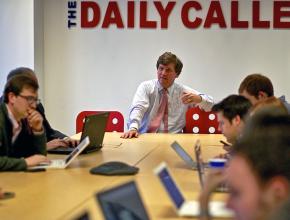Junk-news junkies
In his column for Inside Higher Ed, looks at a new report from Oxford University that documents how the right wing’s "junk news" machine works.
CALLING A fabricated or misleading story "fake news" is less and less an option now that the president has made that the label for information that undermines whatever stories he feels compelled to tell at any given moment. (Never underestimate a bully's capacity to play word games--or to win by changing the rules.)
The effect of Trump's semantic rebranding can be felt in "Polarization, Partisanship and Junk News Consumption Over Social Media in the U.S.," a study issued by the Computational Propaganda Project at Oxford University. Vidya Narayanan and her five co-authors use the expression "fake news" just once in the paper, in a sentence that also appears, slightly tweaked, in the abstract. The researchers define their preferred term, "junk news," as "misleading, deceptive or incorrect information purporting to be about real news about politics, economics or culture."
A distinction without a difference? Perhaps--though I think the Oxford study has less to say about problems of veracity at the level of individual articles than it does about how American public culture is filling up with big bags of garbage.

OLD-FASHIONED public opinion surveying requires finding a demographically representative set of respondents willing to answer a series of questions--and usually to do so by selecting from the range of options established beforehand. The availability to researchers of public pages on social media makes a different sort of analysis possible. Researchers can gather opinions previously expressed, for example, as well as indications of whether those doing the opining are connected, and of how strong those connections are. And all of these data can be collected on a large scale and relatively quickly.
The Oxford study focuses on public communications among Twitter and Facebook users (about 13,500 and 10,700, respectively) in the three months leading up to Donald Trump's first State of the Union. These sources were identified from Computational Propaganda Project sample of over 22 million tweets posted between Nov. 1 and 11, 2016, as well as a data set of about 47,700 public Facebook pages also from the election year.
Networks, communities and interest groups can be mapped via the following and friending connections among users of each social media platform. The results, when translated into graphic form, look like a masses of hundreds of bubbles of various sizes, color-coded according to expressed affinities (Republican or Democrat), media preferences (progressive, conservative, mainstream, local) or special interests (public health, women's rights, conspiracy theory, sustainable farming). And the coloration makes it easier to see how smaller social networks cluster together to form cultural and ideological enclaves--each overlapping somewhat with two or three others, but at considerable distance from the rest.
From the pool of media links shared by Twitter and Facebook users, the researchers found "91 sources of political news and information, which we identified over the course of several years of research and monitoring, produce content that includes various forms of propaganda and ideologically extreme, hyper-partisan and conspiratorial political information." Besides the grinding of axes, these junk-news sources tended to be characterized by a neglect of fact-checking, a failure to publish corrections and the tendency "to present opinion and commentary essays as news."
THE STUDY finds that "a network of Trump supporters" on Twitter "shares the widest range of known junk news sources and circulates more junk news than all the other groups put together," while "on Facebook, extreme hard-right pages--distinct from Republican pages--share the widest range of known junk news sources and circulate more junk news than all the other audiences put together." Finally, "the audiences for junk news on Twitter share a wider range of known junk news sources than audiences on Facebook's public pages."
This is not shocking. It will anger some people, and there is some validity to the complaint that secondhand accounts of the report tend to equate sharing junk news with believing in it. But on the whole, the findings render as charts and correlations something that would otherwise go undoubted: that an already well-funded and well-organized hard-right political movement has forged its own media system (much as Roger Ailes told Richard Nixon would be necessary, decades ago), which has in turn gathered an audience that welcomes "alternative facts" as long as they are delivered with the right tone and feeling.
The authors of the paper note that "social polarization is a driver--just as much as it may be a result--of polarized social media consumption patterns." This is true, although at some point, the distinction becomes moot. Evidence about how fast the vicious circle is spinning is interesting to have, but it seems like time for some research on how to put on the brakes.
First published at Inside Higher Ed.


